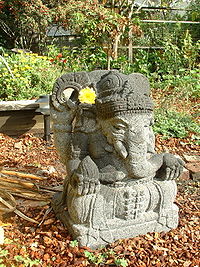- Hindu milk miracle
-
 A statue of Ganesha
A statue of Ganesha
The Hindu milk miracle was a phenomenon, considered by many Hindus as a miracle, which occurred on September 21, 1995.[1] Before dawn, a Hindu worshiper at a temple in south New Delhi made an offering of milk to a statue of Ganesha. When a spoonful of milk from the bowl was held up to the trunk of the statue, the liquid was seen to disappear, apparently taken in by the idol. Word of the event spread quickly, and by mid-morning it was found that statues of the entire Hindu pantheon in temples all over North India were taking in milk.
By noon the news had spread beyond India, and Hindu temples in Britain, Canada, Dubai, and Nepal among other countries had successfully replicated the phenomenon, and the Vishva Hindu Parishad (an Indian Hindu organisation) had announced that a miracle was occurring.
The apparent miracle had a significant effect on the areas around major temples; vehicle and pedestrian traffic in New Delhi was dense enough to create a gridlock lasting until late in the evening. Many stores in areas with significant Hindu communities saw a massive jump in sales of milk, with one Gateway store in England selling over 25,000 pints of milk,[2] and overall milk sales in New Delhi jumped over 30%.[3] Many minor temples struggled to deal with the vast increase in numbers, and queues spilled out into the streets, reaching distances of over a mile.
 A person offering a spoonful of milk to a Hindu idol.
A person offering a spoonful of milk to a Hindu idol.
It should be possible to replace this non-free image with a freely licensed one. If you can, please do so as soon as is practical.Seeking to explain the phenomenon, scientists from India's Ministry of Science and Technology travelled to a temple in New Delhi and made an offering of milk containing a food colouring. As the level of liquid in the spoon dropped, the scientists hypothesized that after the milk disappeared from the spoon, it coated the statue beneath where the spoon was placed. With this result, the scientists offered capillary action as an explanation; the surface tension of the milk was pulling the liquid up and out of the spoon, before gravity caused it to run down the front of the statue.[1] This explanation did nothing to reduce the numbers of faithful rushing to the temples, however, and queues of people carrying pots, pans, and buckets of milk continued to gather. Suzanne Goldenberg, a Delhi-based journalist, reported that: "Inside the darkened shrine, people held stainless steel cups and clay pots to the central figure of the five-headed Shiva, the destroyer of evil, and his snake companion, and watched the milk levels ebb. Although some devotees force-fed the idol enthusiastically, the floor was fairly dry."
To those who believed in the miracle, further proof was offered when the phenomenon seemed to cease before the end of the day, with many statues refusing to take more milk even before noon.[4] A small number of temples outside of India reported the vikramaditya and effect continuing for several more days, but no further reports were made after the beginning of October. However, skeptics hold the incident to be an example of mass hysteria. The story was picked up, mostly as a novelty piece, by news services around the world, including CNN, the BBC, the New York Times and the Guardian.
Contents
2006 miracle
The miracle allegedly occurred again on 20-21 August 2006 in almost exactly the same fashion, although initial reports seem to indicate that it occurred only with statues of Ganesh, Shiva, and Durga. The first reported occurrence was on the evening of the 20th in the city of Bareilly in Uttar Pradesh, from where it quickly spread throughout India.[5] However, rationalists are heavily skeptical about the issue, attributing it to capillary action yet again.[6] The phenomenon had reappeared only days after reports of sea water turning sweet that led to mass hysteria in Mumbai.
2010 miracle
Trinidad Express Newspaper reported on 22 September, 2010 that Ganesh murtis (statues of Hindu god Ganesh) "drank" or accepted milk at Om Shanti Mandir, Cunjal Road, Princes Town, Trinidad on 21 September, 2010 on the occasion of the holy period of Ganesh Utsav.[7]
References
- ^ a b Suzanne Goldenberg, "India's gods milk their faithful in a brief 'miracle'", The Guardian, September 22, 1995.
- ^ David Wooding, "Cow do they do that?", The Sun, September 22, 1995.
- ^ Tim McGirk, "India's thirsty statues drink the nation dry", The Independent, September 22, 1995
- ^ Meenhal Baghel, "Awed devotees witness Shiva miracle across country", The Asian Age, September 22, 1995.
- ^ Shaveta Bansal, "Devotees Throng Temples To See Hindu Deities Drinking Milk", All Headline News, August 21, 2006
- ^ "Milk-drinking gods just plain science", Press Trust of India, August 21, 2006
- ^ Ariti Jankie (Sep 22, 2010). "Ganesh murtis 'drink' milk". Trinidad Express. http://www.trinidadexpress.com/news/Ganesh_murtis__drink__milk_-103591304.html.
External links
Categories:
Wikimedia Foundation. 2010.
